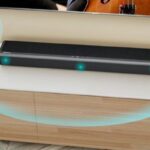
If you’re looking to hook up the Hisense television to your surround-sound system, here are the steps you must take. First, ensure the connection between the television and the surround sound system is turned off. Connect your two devices using an HDMI cable. After the cable has been connected, switch the sound to your surround system and your television. It should be possible to listen to audio from your TV’s stereo system.
More: How To Reset Hisense Sound Bar
How to Connect a Soundbar to a Hisense TV via HDMI
Have you just purchased the latest soundbar with Dolby Atmos and voice assistant? Or any other soundbar with or without a subwoofer. Is it 5.1 or wireless Bluetooth? Note: Connect Hisense Sound Bar To Subwoofer
Is it 5.1 or a Bluetooth-enabled wireless connection? Is it 5.1 or wireless Bluetooth?
Hisense televisions provide excellent audio quality. However, an external audio or soundbar system can provide a more immersive sound experience. Don’t worry, we have prepared this helpful guide to help you connect your Hisense TV with a soundbar.
When connecting an audio bar to a Hisense TV, the wiring is ideal. Suppose you plug an audio cable between your Hisense TV and the sound bar. You’ll enjoy the best sound quality from your home appliances. Many kinds of cables can connect the soundbar to the Hisense television. In reality, you’ll see the whole range of HDMI cables, including the most popular HDMI. HDMI files that are ARC (Audio Return Channel) or HDMI EARC (Enhanced Audio Return Channel). However, it is also possible to hook up a Soundbar and Hisense TV by using an HDMI cable Optical (optical digital audio).
SYNC A WIRELESS SOUNDBAR WITH A HISENSE TV
Suppose you choose a soundbar with Bluetooth, Wi-Fi or wireless technology. It is possible to connect your soundbar to a Hisense TV without cables. However, there are better options than wireless connectivity. Wireless connections can cause latency, which means there could be a shift between audio and image. This is particularly true of Bluetooth connections. If you’re stuck and need to connect the sound bar to a wired Hisense television, we suggest using WiFi.
More: No Sound On Hisense Roku TV
Hisense TV is Not Connected to the Soundbar
If your soundbar cannot be connected to the Hisense TV for no reason, something may be wrong with the device. Before assuming either device is malfunctioning, examine if some common or straightforward issues could be causing the issue. For instance, make sure that both devices have enough power. In addition, you need to make sure that the soundbar is connected to an outlet. If it’s an audio device powered by batteries, it is possible to recharge the battery before you can utilize it.
Another reason could be those external elements preventing the Bluetooth message from reaching your Hisense TV. Distance between two devices can result in a weak connection. Bluetooth signals can only go only a certain distance. The more obstacles that block the signal’s path, the weaker the signal is likely to be. Walls, ceilings, floors, and walls make it difficult to block the Bluetooth signal, but some surfaces might also have materials that can weaken the signal. Bluetooth signals cannot travel through metals, like copper, typically found in ceilings, walls, and floors.
Another reason to be concerned is that the soundbar isn’t equipped to connect with your Hisense TV through Bluetooth, which requires the connection to be made with a cord. It is also possible that the opposite is an issue, so test both options before giving your soundbar. If, however, you cannot connect the soundbar to the Hisense TV, it could be a problem with either of the devices.
You can repair or replace it at no cost, based upon the time the defect or damage was discovered in the first place and the date the problem occurred and was quickly reported to the business you are covered by. Both products come with a limited warranty regarding the amount of time covered and the nature of the damage that is covered. In most cases, the only way to have an audio bar or Hisense TV repaired is to let the issue be an error at the company’s end. If the issue is caused by accident, the blame will fall on your responsibility.
More Post:




